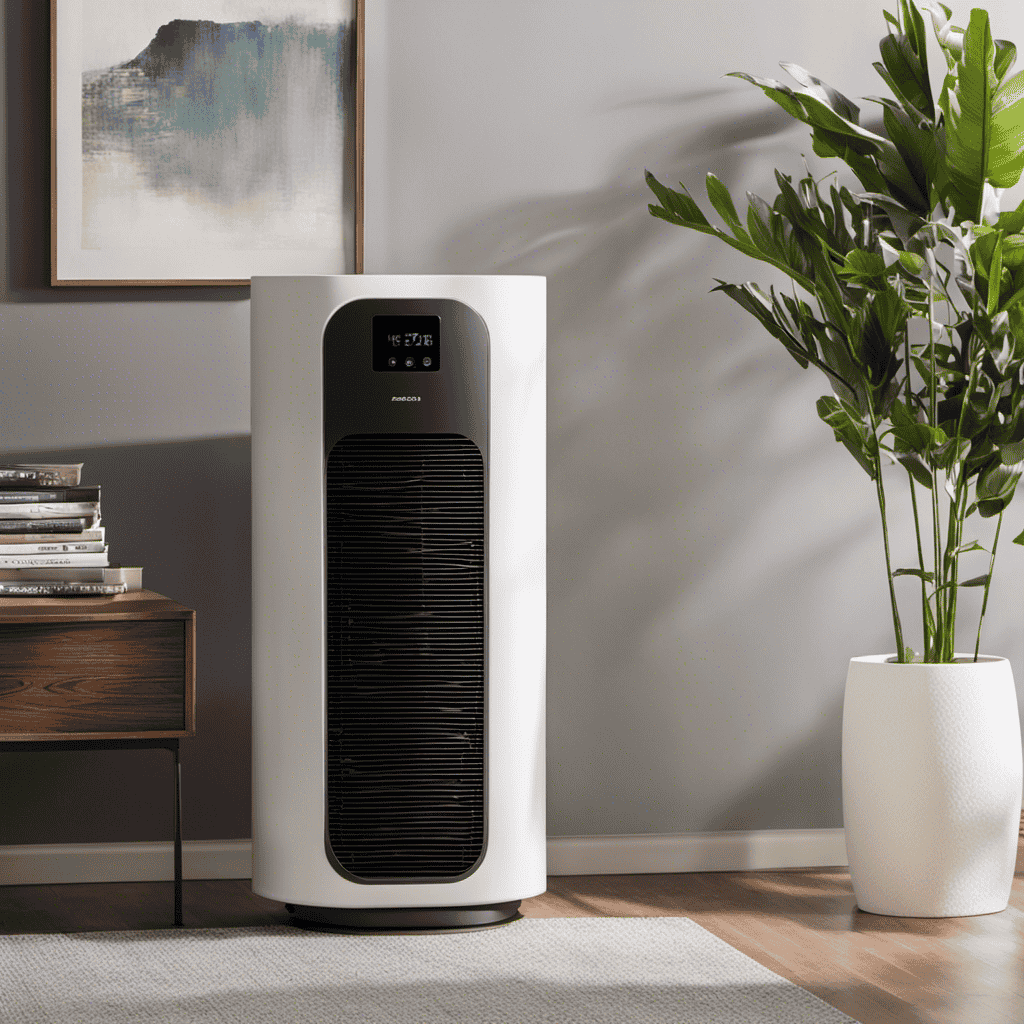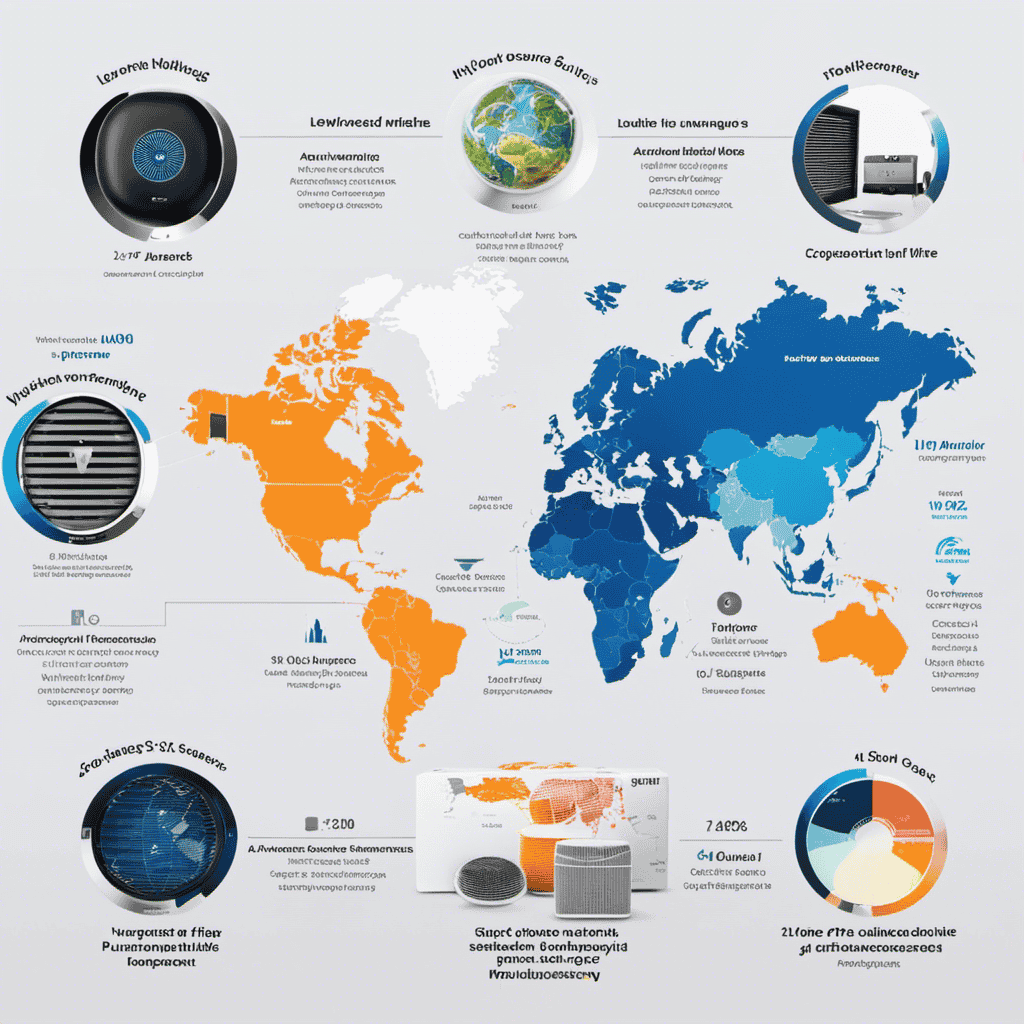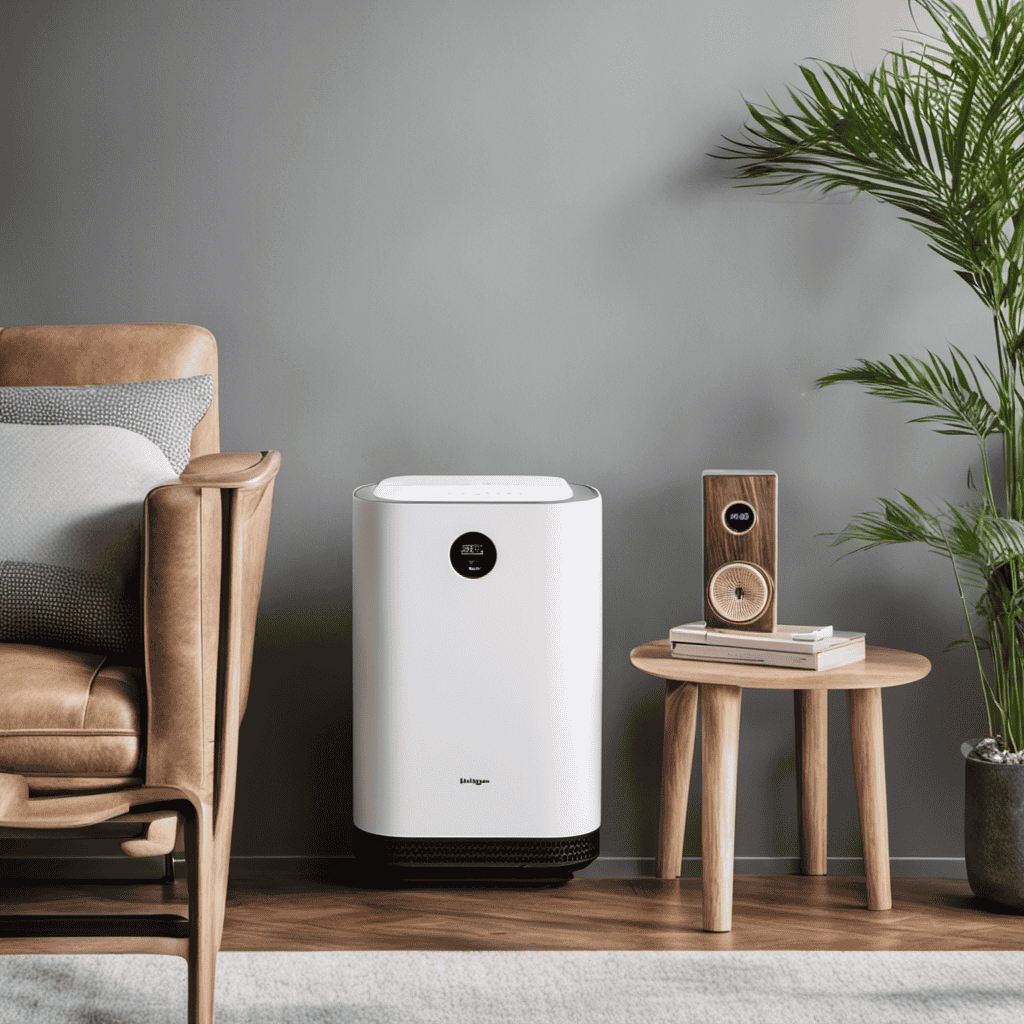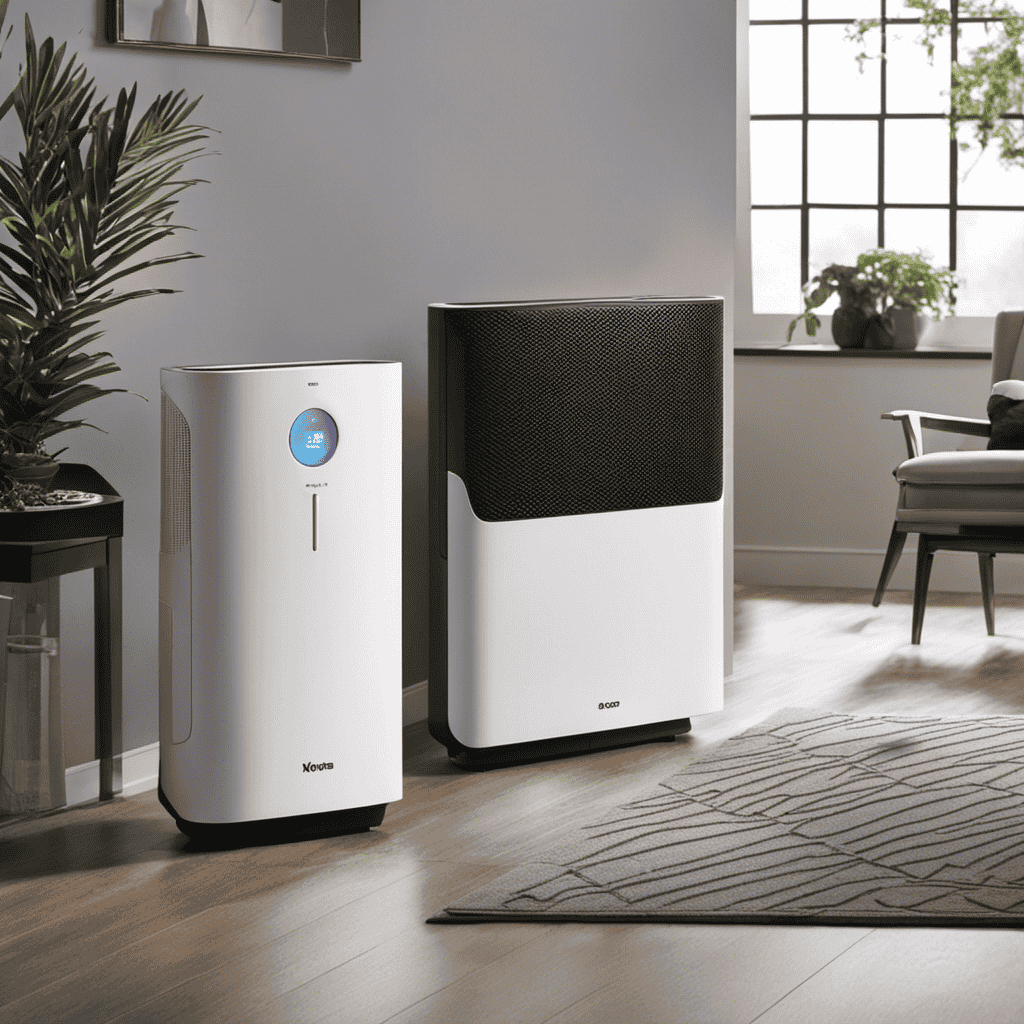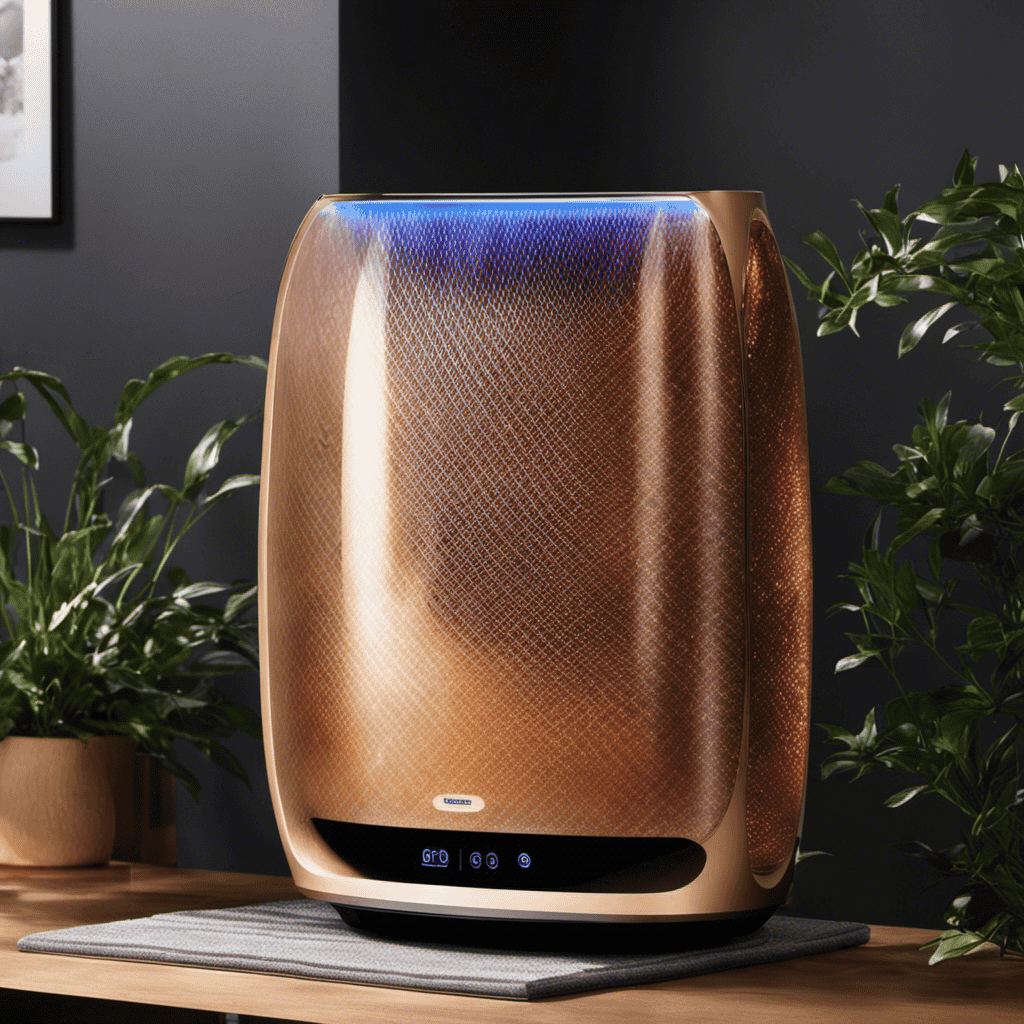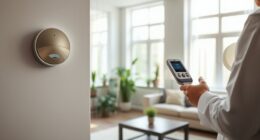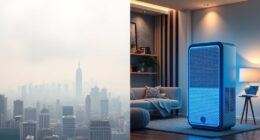As an air quality expert, I have always likened air purifiers to the heroes in the fight for clean air. What distinguishes the champions from the rest?
In this article, I’ll delve into the key factors that make an air purifier stand out from the competition. From performance and filter technology to coverage area and energy efficiency, we’ll explore the characteristics that ensure you’re getting the best air purifier for your needs.
So, let’s dive in and uncover what truly sets the top-tier air purifiers apart.
Key Takeaways
- CADR rating is a key factor in determining the effectiveness of an air purifier in removing pollutants.
- Understanding different filter technologies, such as HEPA, activated carbon, and electrostatic, is essential for optimal performance.
- Consider the coverage area and maximum room size of an air purifier to ensure adequate cleaning.
- Balancing noise level and silent operation is important for creating a peaceful environment while maintaining effectiveness.
Performance
A higher CADR rating usually means the air purifier can clean the air more quickly and efficiently. When comparing the performance of different air purifiers, it is important to consider their CADR ratings. This rating measures the volume of clean air that an air purifier can produce per minute. A higher CADR rating indicates that the air purifier is more effective at removing pollutants from the air.
Additionally, performance comparison should also take into account the size of the room where the air purifier will be used. Some models are designed for smaller spaces, while others are suitable for larger rooms.
Maintenance requirements should also be considered when evaluating performance. Some air purifiers require frequent filter replacements or cleaning, which can be time-consuming and costly. Others may have longer-lasting filters or even washable filters, reducing maintenance needs.
Transitioning to the next section on filter technology, it is important to understand how different types of filters can affect the performance of an air purifier.
Filter Technology
Filter technology plays a crucial role in determining the effectiveness of an air purifier. When it comes to air purifier maintenance and air quality improvement, the type of filter used is of utmost importance. There are different types of filters available in the market, such as HEPA filters, activated carbon filters, and electrostatic filters.
Each type has its own unique properties and capabilities in trapping and removing airborne pollutants. HEPA filters, for example, are highly efficient in capturing small particles like dust, pollen, and pet dander. Activated carbon filters excel in eliminating odors and harmful chemicals. Electrostatic filters use an electric charge to attract and trap particles.
Understanding the filter technology used in an air purifier is essential for ensuring optimal performance and healthier indoor air.
Now let’s delve into another important aspect of air purifiers – the coverage area.
Coverage Area
When considering the coverage area of an air purifier, two key factors to take into account are the maximum room size and the effective square footage.
The maximum room size refers to the largest space that the air purifier can effectively clean, ensuring that the air quality remains optimal.
On the other hand, effective square footage refers to the actual area that the air purifier can efficiently clean, taking into account factors such as the airflow rate and the type of filtration technology used.
It is important to consider both of these factors when selecting an air purifier to ensure that it can adequately cover the desired space and effectively improve indoor air quality.
Maximum Room Size
The maximum room size an air purifier can effectively cover depends on its fan power and filtration system. A larger room requires a more powerful air purifier to effectively circulate and clean the air. The fan power determines how fast the air is circulated, while the filtration system determines the efficiency of removing particles and pollutants from the air.
It’s important to consider the size of the room you want to purify when choosing an air purifier. The coverage area mentioned by manufacturers is often based on optimal conditions. Therefore, it’s advisable to choose an air purifier that covers a slightly larger area than your actual room size. This ensures that the air quality is effectively improved and the purification rate remains high.
Effective Square Footage
Choosing an air purifier that covers a slightly larger area than your actual room size ensures that the air quality is effectively improved and the purification rate remains high. This is because the purifier will be able to efficiently remove pollutants and allergens from the air, even in larger spaces.
When considering the effective square footage of an air purifier, it’s important to take into account the size of your room and the level of air pollution in your area. Here are some key factors to consider:
- Room size: Measure the square footage of your room to determine the appropriate air purifier size.
- Air quality: Consider the level of pollutants and allergens in your area to choose a purifier with the right filtration capabilities.
- Purification rate: Look for an air purifier with a high Clean Air Delivery Rate (CADR) to ensure efficient and effective air cleaning.
- Filter replacement: Check how often the filters need to be replaced and consider the cost and availability of replacement filters.
- Noise level: Consider the noise level of the air purifier, especially if you plan to use it in a bedroom or office space.
Considering these factors will help you choose an air purifier that effectively improves air quality in your specific room size.
Noise Level
When considering an air purifier, one important factor to consider is its noise level. Silent operation is a desirable feature as it allows for a peaceful and uninterrupted environment.
However, it is crucial to strike a balance between quietness and effectiveness. A purifier that is too quiet may not be effective in effectively removing pollutants from the air, while one that is too loud may cause discomfort.
Silent Operation
One of the key factors in determining a good air purifier is how silently it operates. When it comes to silent operation, there are a few crucial factors to consider:
-
Noise Level: A good air purifier should have a noise level of less than 50 decibels, ensuring a peaceful and quiet environment.
-
Soundproof Design: Look for air purifiers with soundproofing features to minimize noise transmission and create a more serene atmosphere.
-
Efficient Motor: A powerful yet quiet motor is essential for effective air purification without disturbing your peace.
-
Intelligent Sleep Mode: Air purifiers with sleep mode automatically adjust their fan speed to maintain a quiet operation while you sleep.
-
Noise Reduction Technology: Some air purifiers are equipped with noise reduction technology, further minimizing any operational noise.
In addition to silent operation, a good air purifier should also be low maintenance and user-friendly. These features make it easier to clean and operate the purifier, ensuring a hassle-free experience for the user.
Quietness Vs Effectiveness
When it comes to air purifiers, there is often a trade-off between quietness and effectiveness. While a silent operation is desirable for many, it can sometimes come at the expense of efficiency. Airflow control plays a crucial role in determining the overall effectiveness of an air purifier. A well-designed airflow system allows for optimal circulation and filtration of air, ensuring that pollutants are efficiently removed. However, achieving this level of airflow control while maintaining a quiet operation can be challenging and may require more advanced technology and higher manufacturing costs.
To illustrate this trade-off, consider the following table:
| Air Purifier | Airflow Control | Effectiveness | Cost |
|---|---|---|---|
| Model A | Limited | Moderate | Low |
| Model B | Advanced | High | High |
As shown in the table, Model B offers superior airflow control and effectiveness, but it comes at a higher cost. On the other hand, Model A, with limited airflow control, may be more affordable but may not provide the same level of purification. Ultimately, the choice between quietness and effectiveness depends on individual preferences and priorities.
Energy Efficiency
An air purifier’s energy efficiency can greatly impact its overall performance. When it comes to choosing the best air purifier, considering its energy efficiency is crucial for both cost savings and environmental impact. Here are five key reasons why energy efficiency matters:
-
Cost savings: An energy-efficient air purifier consumes less electricity, resulting in lower energy bills over time.
-
Environmental impact: By reducing energy consumption, energy-efficient air purifiers help minimize greenhouse gas emissions and contribute to a cleaner environment.
-
Longer lifespan: Energy-efficient models tend to have better built-in components and advanced technologies, resulting in a longer lifespan for the purifier.
-
Quieter operation: Energy-efficient air purifiers often feature quieter motors and fans, providing a more peaceful and undisturbed indoor environment.
-
Improved performance: An energy-efficient air purifier can maintain its performance level consistently, ensuring effective air filtration and purification throughout its lifespan.
Considering these factors, opting for an air purifier with high energy efficiency can bring both economic and environmental benefits.
Additional Features
Opting for an air purifier with additional features can enhance its overall performance and provide added convenience. One such feature that sets some air purifiers apart is smart connectivity. With smart connectivity, you can easily control and monitor your air purifier from your smartphone or other smart devices. This allows you to adjust settings, set timers, and even receive notifications about air quality.
Another important feature is a user-friendly interface. A well-designed interface makes it easy to navigate through different settings and modes, ensuring a hassle-free experience. It should provide clear information about air quality levels and filter status, allowing you to make informed decisions. A user-friendly interface simplifies the operation, making it accessible to everyone, even those who are not tech-savvy.
These additional features contribute to a more efficient and convenient air purifier experience.
Frequently Asked Questions
Can an Air Purifier Eliminate All Types of Pollutants?
An air purifier can effectively eliminate various types of pollutants, including mold spores. Its filter is designed to capture and remove these particles from the air, improving indoor air quality and reducing potential health risks.
Can an Air Purifier Prevent the Spread of Viruses and Bacteria?
Yes, an air purifier can prevent the spread of viruses and bacteria. Its effectiveness lies in its ability to filter and capture airborne particles, reducing the risk of respiratory infections and improving overall air quality. Using an air purifier has numerous benefits.
How Often Should I Replace the Filters in My Air Purifier?
When it comes to replacing filters in my air purifier, I consider factors like the manufacturer’s recommendations, the air quality in my home, and the frequency of use. Regular filter replacements ensure optimal performance and cleaner air.
Can an Air Purifier Remove Odors From My Home?
Yes, an air purifier can effectively remove odors from your home. Regular maintenance, such as replacing filters, is important to ensure the air purifier continues to work efficiently and effectively.
Can an Air Purifier Help With Allergies and Respiratory Issues?
Can an air purifier help with allergies and respiratory issues? Yes, it can. Air purifiers are effective in removing allergens and pollutants from the air, providing cleaner and healthier indoor air quality.
Conclusion
In conclusion, after thoroughly analyzing various factors, it is clear that not all air purifiers are created equal.
Performance plays a crucial role in determining the effectiveness of an air purifier, with higher CADR (Clean Air Delivery Rate) values indicating better air cleaning capability.
An interesting statistic to consider is that air pollution is responsible for 7 million premature deaths worldwide each year, making it imperative to invest in a high-performance air purifier to safeguard our health and well-being.
So, when choosing an air purifier, make sure to prioritize performance and choose one that can truly make a difference in your indoor air quality.
